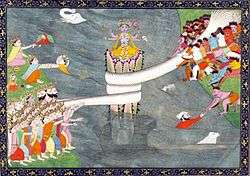Andal
Andal (Tamil: ஆண்டாள், Āṇṭāḷ ) or Godadevi is the only female Alvar among the 12 Alvar saints of South India. The Alvar saints are known for their affiliation to the Srivaishnava tradition of Hinduism. Active in the 8th-century,[2][4] with some suggesting 7th-century,[3][note 1] Andal is credited with the great Tamil works, Thiruppavai and Nachiar Tirumozhi, which are still recited by devotees during the winter festival season of Margazhi. Andal is an important female figure for women in South India and has inspired women's groups such as Goda Mandali.[6]
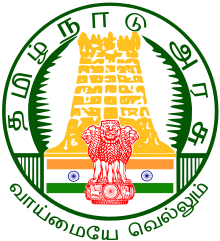
Andal Godadevi | |
|---|---|
Devi Andal or Godadevi idol | |
| Personal | |
| Born | Kodhai 7th or 8th century CE[1][2][3] |
| Religion | Hinduism |
| Philosophy | Vaishnavism Bhakti |
| Religious career | |
| Literary works | Thiruppavai, Nachiar Tirumozhi |
| Honors | Alvars |
Legend of Andal
Periazhwar (originally called Vishnuchittar) was an ardent devotee of Perumal and he used to string garland to god every day. He was childless and he prayed to God to save him from the longing. One day, he found a girl child under a Tulasi plant in a garden inside the temple. The child was goddess Sri Mahalakshmi herself. He and his wife named the child as Kothai, who grew up as a devotee of Lord Krishna, an avatar of Vishnu, the supreme God. She is believed to have worn the garland before dedicating it to the presiding deity of the temple. Periazhwar, who later found it, was highly upset and remonstrated her. Lord Vishnu appeared in his dream and asked him to dedicate only the garland worn by Andal to him. The girl Kothai was thus named Andal and was referred to as சூடிகொடுத்த சுடர்க்கொடி, or "Chudikodutha Sudarkodi" (lady who wore and gave her garland) to Lord Vishnu. The practise is followed during modern times when the garland of Andal from Srivilliputhur Andal Temple is sent to Tirumala Venkateswara Temple on Garudotsavam during the Tamil month of Purattaasi (September – October) and Azhagar Koyil during Chitra Pournami.[7]
Devotion to Perumal
Kodhai was brought up by Vishnuchitta (Periyalvar) in an atmosphere of love and devotion. As Kodhai grew into a beautiful maiden, her fervor for the Lord grew to the extent that she decided to marry only the Lord himself. As time passed, her resolve strengthened and she thought constantly about marrying Ranganathar of Thiruvarangam (the reclining form of Vishnu).[8][9]
Andal's Bhakti
In North India, Radha Rani is celebrated as the "Queen of Bhakti (devotion)." Among the female devotees, Mirabai's name is also taken as an example of complete devotion or Bhakti to Lord Krishna. Similarly, in Tamil Nadu Andal is remembered for her pure love and devotion. In the Thiruppavai, Andal, as a Gopi in Ayarpadi (Brindavan),[10] emphasizes that the ultimate goal of life is to seek surrender and refuge at the Lord's feet.
Andal's Garlands
It is also believed that Ranganatha of Ranganathaswamy temple married Andal, who later merged with the idol. Since Andal married Ranganatha, who came as king Raja Sriman Andhra Vishnu, the presiding deity is called Rangamannar.[11]
Andal's garland and Tirupati Venkateswara
For Tirupati Brahmotsavam, garlands worn to Andal in Srivilliputhur temple are sent to Venkateswara Temple at Tirupati in Andhra Pradesh. These traditional garlands are made of tulasi, sevanthi and sampangi flowers. These garlands are worn by Lord Venkateswara during the Garuda seva procession.[12]
Every year Tirupati Venkateswara's garland is sent to Srivilliputtur Andal for marriage festival of Andal.[13]
Kallazhagar
Andal garland is also sent to Madurai Kallazhagar temple for the Chithirai Festival.[13]
Andal's Parrot
Srivilliputhur Andal's hand-crafted parrot is made with fresh green leaves each and every day. This parrot is kept in the left hand of Andal.[15] It takes approximately four and half hours to make this parrot. A pomegranate flower for beak and mouth, Bamboo sticks for legs, banana plant, petals of pink oleander and nandiyavattai are used to prepare this parrot.[16]
Literary works
Andal composed two literary works, both of which are in Tamil verse form and express literary, philosophical, religious, and aesthetic content.
Thiruppavai
Her first work is the Thiruppavai, a collection of 30 verses in which Andal imagines herself to be a Gopi, one of the cowherd girls known for their unconditional devotion to Lord Krishna. In these verses, she describes her yearning to serve Lord Vishnu and achieve happiness not just in this lifetime, but for all eternity. She also describes the religious vows (pavai) that she and her fellow cowherd girls will observe for this purpose. It is said that Thiruppavai is the nectar of Vedas and teaches philosophical values, moral values, ethical values, pure love, devotion, dedication, single-minded aim, virtues, and the ultimate goal of life.[17][18]
Nachiar Tirumozhi
The second work by Andal is the Nachiar Tirumozhi, a poem of 143 verses. "Thirumozhi" literally means "Sacred Sayings" in a Tamil poetic style and "Nachiar" means Goddess. Therefore, the title means "Sacred Sayings of the Goddess." This poem fully reveals Andal's intense longing for Vishnu, the Divine Beloved. Utilizing classical Tamil poetic conventions and interspersing stories from the Vedas and Puranas, Andal creates imagery that is possibly unparalleled in the whole gamut of Indian religious literature. However, conservative vainava institutions do not encourage the propagation of Nachiar Tirumozhi as much as they encourage Thiruppavai because Nachiar Tirumozhi belongs to an erotic genre of spirituality that is similar to Jayadeva's Gita Govinda.[19][20][21][22][23]
Importance in southern part of India

Andal is one of the best-loved poet-saints of the Tamils. Pious tradition holds her to be the incarnation of Bhūmi Devi (Sri Lakshmi as Mother Earth) to show humanity the way to Lord Vishnu's lotus feet. Representations of her next to Vishnu are present in all vaishnava temples. During the month of Margazhi, discourses on the Thiruppavai in Tamil, Telugu, Kannada, and Hindi take place all over India.[24] The Srivilliputhur Divya Desam at Srivilliputhur consists of twin temples, one of which is dedicated to Andal. Most South Indian Vishnu temples have a separate shrine for Andal. There are a number of festivals dedicated to Andal, among the most notable being the Pavai Nonbu in the Tamil month of Margazhi (December – January), Andal Thirukalyanam in Panguni, Pagalpathu, Rapathu, Adi Thiruvizha, when Andal is depicted seated in the lap of Ranganathar.[25] Andal is known for her unwavering devotion to Lord Vishnu, the God of the Gods. Adopted by her father, Periyalvar, Andal avoided earthly marriage, the normal and expected path for women of her culture, to marry Vishnu, both spiritually and physically. In many places in India, particularly in Tamil Nadu, Andal is treated more than a saint and as a form of god herself and a shrine for Andal is dedicated in most Vishnu temples.[26]
Festivals
Thousands of people from the state Tamil Nadu participate in the "Aadi Pooram" festival celebrated in the Andal Temple. After early morning special pujaas, the presiding deities, Shri Rengamannar and Goddess Andal are taken in decorated palanquins to the car. The festival marks the adoption of presiding deity, Andal, by Periyazhwar after he found her near a Tulsi plant in the garden of Vatapatrasayi Temple at Srivilliputhur on the eighth day of the Tamil month of Aadi.[27][28]
Women groups inspired by Andal
In poetry, 9th-century Andal became a well known Bhakti movement poetess, states Pintchman, and historical records suggest that by 12th-century she was a major inspiration to Hindu women in south India and elsewhere.[6] Andal continues to inspire hundreds of classical dancers in modern times choreographing and dancing Andal's songs.[29] Andal is also called Goda, and her contributions to the arts have created Goda Mandali (circle of Andal) in the Vaishnava tradition.[29]
Through poetry of saints (such as Andal) women are thought to be able to connect with the Lord directly and those words are thought to encapsulate their personal emotions.[6]
Goda Mandali
Goda Mandali (circle) which was named after Andal was formed in 1970 and reorganized in 1982 spreads Andal songs widely through TV and radio programs.[30][31] The group would gather weekly to learn songs and would sing at events such as festivals where they would raise money for shrines.[31]
Contemporary commentaries and inspired poems
Bhakti Poetry
In contemporary commentaries on Tamil bhakti poetry, A.K. Ramanujan's work remarks on how many other religious traditions would keep and treat passionate love and devotion to God as separate, while in the bhakti tradition, they can be in resonance with one another:
"All devotional poetry plays on the tension between saguna and nirguna, the lord as person and the lord as principle. If he were entirely a person, he would not be divine, and if he were entirely a principle, a godhead, one could not make poems about him. The Vaishnavas, too, say that the lord is characterized by both 'paratva, 'otherness' and soulabhaya, 'ease of access'; he is both here and beyond, both tangible as a person and intangible as a principle-such is the nature of the ground of all being. It is not either/or, but both and; myth, bhakti and poetry would be impossible without the presence of both attitudes". Prentiss, Karen Pechilis (1999). The Embodiment of Bhakti. OUP. p. 25. ISBN 9780195128130.
Interpretations by Feminist
Andal's Poetry
It is thought that women used poetry as a tool in Hindu society as a way to claim a form of agency.[32]
Feminist interpretations look at some of Andal's verses as her open acknowledgement of her love for Lord Vishnu, written with bold sensuality and startlingly savage longing, hunger and inquiry as widely found in Tamil Sangam literature that express women's longings and their separation from their men; even today, her most erotic poems are rarely rendered publicly.[33] In one such verse Andal dispenses with metaphor and imagines herself lying in the arms of Krishna, making love to him:[34]
My life will be spared
Only if he will come
To stay for me for one night
If he will enter me,
So as to leave
the imprint of his saffron paste
upon my breasts
Mixing, churning, maddening me inside,
Gathering my swollen ripeness
Spilling nectar,
As my body and blood
Bursts into flower.
William Dalrymple- In search of Tamil Nadu's poet-preachers[35][36]
tell him I will survive
only if he will stay with me
for one day –
enter me
so as to wipe away
the saffron paste
adorning my breasts
Vidya – The Body Adorned: Sacred and Profane in Indian Art(p. 140)[37]
Andal admiring herself whilst wearing the garland that was meant for the deity:
the guilt glazed love lay on Andal's breasts.
thick and heavy as him.
frightened with force
and locked away, she conjured him every night,
her empurumaan, her emperor-man.
- Meena Kandasamy, Ms Militancy[38][39][40]
In one of her poems, Andal says that her voluptuous breasts will swell for the Lord alone, and scorns the idea of making love to mortal beings, comparing that with the sacrificial offering made by Brahmins being violated by jackals in the forest,[41] and in another verse she dedicates her swelling breasts to the Lord who carries a conch.[36]
My surging breasts long to leap to the touch of his hand which holds aloft the flaming discus and the conch.
Coax the world-measurer to caress my waist, to encircle the twin globes of my breasts
Marriage to Vishnu
Contemporary interpretations view her act of marrying Vishnu as feminist.[44] Divine marriages and virginity allowed women's subjectivity, as she is able to choose her husband, and given an "aristocratic freedom".[45] It is said that by devoting herself to God and rejecting marrying a human, she avoided the regular duties involved with being a wife that would inhibit her freedom.[44] Feminist interpretations see Andal's pursuit of marrying Vishnu as rejecting the patriarchal institution of marriage.[44] Virgins with divine marriages were often able to practice educational freedom through reading and/or writing[45] such as Andal did.
Quoted from Feminism and world religions by Arvind Sharma, Katherine K. Young: "What Andal and other women poets did by living the way they did was to negotiate a space within a marriage-dominated society and made at least some sections of society make room for them".[44]
Andal fulfilled the expectation of becoming a wife by marrying God, but since her husband was divine, she gained her autonomy.[44] This act is referred to as virginal feminism by numerous scholars in patristic theology.[46] Virginity is viewed as giving women the option to avoid childbearing, "male domination" and live a new life of devotion to God.[46]
Krishnadevaraya's Amuktamalyada
Krishnadevaraya of the Vijayanagar Dynasty composed the epic poem Amuktamalyada in Telugu, which is considered as a masterpiece. Amuktamalyada translates to one who wears and gives away garlands, and describes the story of Andal or Goda Devi, the daughter of Periyalvar.[47]
Amuktamalyada describes pain of separation (viraha) experienced by Andal, who is described as the incarnate of Lakshmi the consort of Vishnu. Further the poem describes Andal's beauty in 30 verses written in the keśādi-pādam style, starting from her hair, going down her body till her feet.[48][49]
Mangalasasanam
Andal has sung in praise of eleven holy sites:[50]
| S.No. | Name of the temple | Location | Photo | Number of Pasurams | Presiding deity | Notes/Beliefs |
|---|---|---|---|---|---|---|
| 1 | Sri Rangam | 10.8625°N 78.689722°E | 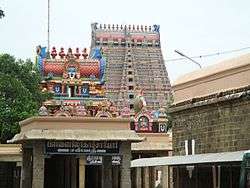 |
10 | Sri Ranganatha Swamy Sri Ranganayaki Thayar |
Thiruvarangam temple is often listed as the largest functioning Hindu temple in the world, the still larger Angkor Wat being the largest existing temple. The temple occupies an area of 156 acres (631,000 m²) with a perimeter of 4,116m (10,710 feet) making it the largest temple in India and one of the largest religious complexes in the world.[51][52] The annual 21-day festival conducted during the Tamil month of Margazhi (December–January) attracts 1 million visitors.[53] |
| 2 | Paramapadam | Heavenly | 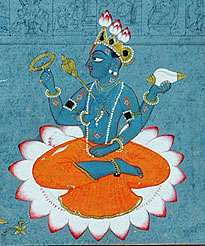 Vishnu, Lord of Vaikuntha |
1 | Sri Paramapada Nathan Sri Periya Piratti |
Vaikuntha is the celestial abode of Vishnu.[54][55][56] Vaikuntha is an abode exclusive to him, his consort Lakshmi and other liberated souls that have gained moksha. |
| 3 | Tirupathi | 13.143°N 79.907°E | 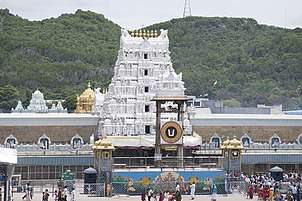 |
18 | Sri Venkateswara Swamy Sri Alarmelmangai Thayar |
Venkateswara Temple is a landmark Vaishnavite temple situated in the hill town of Tirumala at Tirupati in Chittoor district of Andhra Pradesh, India. The Temple is dedicated to Lord Thiru Venkateswara, an incarnation of Vishnu, who is believed to have appeared here to save mankind from trials and troubles of Kali Yuga. Hence the place has also got the name Kaliyuga Vaikuntham and Lord here is referred to as Kaliyuga Prathyaksha Daivam.[57] |
| 4 | Thiruparkadal | Heavenly | 3 | Sri Ksherabthinathan Sri Kadalmagal Nachiyar |
In Hindu cosmology, Thiruparkadal (Ocean of milk) is the fifth from the center of the seven oceans. It surrounds the continent known as Krauncha.[58] According to Hindu mythology, the devas (gods) and asuras (demons) worked together for a millennium to churn the ocean and release Amrita the nectar of immortal life.[59] It is spoken of in the Samudra manthana chapter of the Puranas, a body of ancient Hindu legends. It is also the place where Vishnu reclines over Shesha Naga, along with his consort Lakshmi. | |
| 5 | Mathura | 27.504748°N 77.669754°E | 19 | Sri Govardhanesan Sri Sathyabama |
The temple in Mathura, is among the most sacred of Hindu sites, and is revered as the birthplace of Krishna.[60] Kehsav Dev (Krishna) is the deity of this temple. According to traditions, the original deity was installed by Bajranabh, who was great-grandson of Krishna.[61] | |
| 6 | Dwarka | 22°14′16.39″N 68°58′3.22″E |  Dwarka temple |
4 | Sri Dwarakadeesha Perumal Sri Kalayana Nachiyar |
The temple is dedicated to the god Krishna, who is worshiped here by the name Dwarkadhish, or 'King of Dwarka'. The main shrine of the 5-storied building, supported by 72 pillars, is known as Jagat Mandir or Nija Mandir, archaeological findings suggest it to be 2,200 – 2,000 years old.[62][63][64] Temple was enlarged in the 15th- 16th century.[65][66] |
| 7 | Thirumaliruncholai | 10.074136°N 78.214356°E | .jpg) Temple tower |
11 | Sri Kallazhagar Sri Sundaravalli Thayar |
The temple is constructed in the Dravidian style of architecture. A granite wall surrounds the temple, enclosing all its shrines. The temple has a seven-tiered rajagopuram. The temple is surrounded by a large fort, part of which is dilapidated. Kallazhagar is believed to have appeared sage Suthapava. The temple follows Thenkalai tradition of worship.[67] |
| 8 | Thirukudanthai | 10°57′34″N 79°22′29″E | Temple tower |
1 | Sri Sarangapani Perumal Sri Komalavalli Thayar |
This temple is along Kaveri and is one of the Pancharanga Kshetrams. The temple is believed to be of significant antiquity with contributions at different times from Medieval Cholas, Vijayanagar Empire and Madurai Nayaks. The temple is enshrined within a granite wall and the complex contains all the shrines and the water tanks of the temple. The rajagopuram (the main gateway) has eleven tiers and has a height of 173 ft (53 m).[68] |
| 9 | Thirukannapuram | 10°52′7″N 79°42′6″E | Temple tower |
1 | Sri Sowriraja Perumal Sri Kannapura Nayagi |
The presiding deity is believed to have appeared with a wig (called sowri locally) to save a devotee, leading to the name Sowrirajan. A granite wall surrounds the temple, enclosing all its shrines and three of its seven bodies of water. The temple has a seven-tiered rajagopuram, the temple's gateway tower and a huge temple tank in front of it. The temple is believed to have been built by the Cholas, with later additions from the Thanjavur Nayaks.[69] |
| 10 | Srivilliputhur | 9°30′32″N 77°37′56″E | 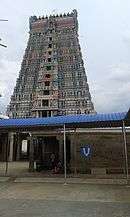 Temple tower |
1 | Sri Vadapatrasayanar Sri Andal |
The temple is associated with the life of Andal, who, according to legend, was found by Periazhwar under a Tulsi plant in the garden inside the temple. She is believed to have worn the garland before dedicating it to the presiding deity of the temple. Periazhwar, who later found the garland, was highly upset and stopped the practice. It is believed Vishnu appeared in his dream and asked him to dedicate the garland worn by Andal to him daily, a practice followed unto the modern day. It is also believed that Ranganatha of Thiruvarangam Ranganathaswamy temple married Andal, who later merged with him. The temple has two divisions – the one of Andal located on the southwestern and the second one on the northeastern side. A granite wall surrounds the temple, enclosing all its shrines, the garden where Andal is believed to have been born and two of its three bodies of water. The Vijayanagar and Nayak kings commissioned paintings on the walls of the shrine of temple, some of which are still present.[70][11] |
| 11 | Thiruvaipadi | 26.95009444667719°N 80.43869165722663°E | Gokul temple |
4 | Sri Navamohana Krishna Sri Rukmini Sathyabama |
believe that Lord Krishna spent his childhood in this place. |
See also
- Thiruppavai
- Nachiar Tirumozhi
- Srivilliputhur Andal Temple
- Amuktamalyada
References
- Chitnis, Krishnaji Nageshrao (2003). Medieval Indian History. Atlantic Publishers & Dist. p. 116. ISBN 978-81-7156-062-2.; Quote: Andal, a woman saint (ninth century)...
- Bryant, Edwin Francis (2007). Krishna: A Sourcebook. Oxford University Press. p. 188. ISBN 978-0-19-803400-1.
- S. M. Srinivasa Chari (1 January 1997). Philosophy and Theistic Mysticism of the Āl̲vārs. Motilal Banarsidass. pp. 11–12. ISBN 978-81-208-1342-7.
- Chitnis, Krishnaji Nageshrao (2003). Medieval Indian History. Atlantic Publishers & Dist. p. 116. ISBN 978-81-7156-062-2.
- Greg Bailey; Ian Kesarcodi-Watson (1992). Bhakti Studies. Sterling Publishers. ISBN 978-81-207-0835-8.
- Tracy Pintchman (2007), Women's Lives, Women's Rituals in the Hindu Tradition, Oxford University Press, ISBN 978-0195177077, pages 181–185
- Rao, A.V.Shankaranarayana (2012). Temples of Tamil Nadu. Vasan Publications. pp. 195–99. ISBN 978-81-8468-112-3.
- "Andal Biography". freeindia.org. Archived from the original on 23 July 2007. Retrieved 10 July 2007.
- Gopal, Madan (1990). K.S. Gautam (ed.). India through the ages. Publication Division, Ministry of Information and Broadcasting, Government of India. p. 192.
- http://ebooks.tirumala.org/Home/Download/?ID=1929
- Anantharaman, Ambujam (2006). Temples of South India. East West Books (Madras). pp. 177–181. ISBN 978-81-88661-42-8.
- "ANDAL MALA PRESENTED TO LORD VENKATESWARA IN TIRUMALA – TTD News". news.tirumala.org. Retrieved 19 September 2017.
- kmdilip. "Srivilliputtur Andal Temple – Andal Temple". www.srivilliputtur.co.in. Retrieved 19 September 2017.
- "isbn:8174781757 – Google Search". books.google.com. Retrieved 19 September 2017.
- http://www.andaljeeyar.org/images/pdf/SRIVILLIPUTHUR.pdf
- Krishnamachari, Suganthy (8 August 2013). "Labour of love". The Hindu.
- "Life of Andal". thiruppavai.org tiruppavai.org. Archived from the original on 5 July 2007. Retrieved 10 July 2007.
- "Andal's Wedding". youtube. Retrieved 20 April 2013.
- Rao, Shivshankar (31 March 2013). "Saints – Andal". Sushmajee: Dictionary of Hindu Religion Sketches. US Brahman Group. Retrieved 11 August 2015.
- Andal (14 October 2000). Andal: Tiruppavai/Nachiyar Tirumozhi. Penguin Books Australia. ISBN 0140245723.
- "Nachiyar aesthetically conceived". The Hindu. 5 January 2001. Retrieved 11 August 2015.
- Muthukumaraswamy, MD (25 August 2016). "In Tamil lit, an erotic bhakti for Krishna". The Times of India. Retrieved 25 January 2018.
- Rajarajan, R.K.K. (2015). "Art and Literature: Inseparable Links". The Quarterly Journal of the Mythic Society.
- "Āndāl, Saint Goda". womenshistory.about.com. Archived from the original on 26 October 2007. Retrieved 10 July 2007.
- S., Manickavasagam (2009). Power of Passion. Strategic Book Publishing. p. 163. ISBN 9781608605613.
- "Architectural grandeur". The Hindu. Chennai, Tamil Nadu, India. 12 August 2005.
- "Thousands of devotees likely to throng Thiruvilliputtur today". The Hindu. Chennai, India. 25 July 2009. Retrieved 19 February 2013.
- "Hundreds participate in Andal Temple car festival". The Hindu. Chennai, India. 30 July 2006.
- Tracy Pintchman (2007), Women's Lives, Women's Rituals in the Hindu Tradition, Oxford University Press, ISBN 978-0195177077, pages 185–187
- "isbn:0198039344 – Google Search". books.google.com. Retrieved 19 September 2017.
- Women's Lives, Women's Rituals in the Hindu Tradition;page 186
- Bose, Mandakranta (2010). Women in the Hindu Tradition: Rules, roles and exceptions. London & New York: Routledge. pp. 112–119.
- Rajarajan, R K K (2015). "Art and Literature: Inseparable Links". The Quarterly Journal of the Mythic Society. 106 (4): 53–61. Retrieved 28 April 2017.
- Lakshmi, C S (7 December 2003). "Landscapes of the body". The Hindu. Retrieved 25 January 2018.
- Dalrymple, William (10 July 2015). "In search of Tamil Nadu's poet-preachers". Financial Times (London). The Financial Times Limited. Retrieved 13 July 2015.
- Chakravarty, Uma (1989). "The World of the Bhaktin in South Indian Traditions – The Body and Beyond" (PDF). Manushi. 50-51-52: 25. Retrieved 18 September 2015.
- Dehejia, Vidya (2008). The Body Adorned: Sacred and Profane in Indian Art. New York: Columbia University Press. p. 141. ISBN 9780231512664.
- Kandasamy, Meena (2010). Ms Militancy. Narayana. ISBN 9788189059347.
- Mulchandani, Sandhya (2014). "Divine Love". The Indian Quarterly. Retrieved 11 August 2015.
- Bilwakesh, Champa (16 March 2011). "Ms Militancy, by Meena Kandasamy". Archived from the original on 18 November 2015. Retrieved 11 August 2015.
- Ghai, Anuj. "Reflections on Andal". Academia.edu. Retrieved 22 July 2015.
- Chabria, Priya Sarukkai (2016). Chabria, Priya Sarukkai; Shankar, Ravi (eds.). Andal: The Autobiography of a Goddess. Zubaan Books. ISBN 9789384757670.
- Venkatesh, Arundhati (17 May 2016). "Andal: The Tamil Female Saint Brought To You in a Very Satisfying Translation [Book Review]". Women's Web. Retrieved 25 January 2018.
- Sharma, Arvind; Young, Katherine K. (1999). Feminism and world religions. SUNY Press. pp. 41–43.
- Wogan-Browne, Jocelyn (1 March 2001). Saints' Lives and Women's Literary Culture, 1150–1300. Oxford University Press. doi:10.1093/acprof:oso/9780198112792.001.0001. ISBN 978-0-19-811279-2.
- Ruether, Rosemary Radford (1974). Religion and Sexism. New York: Simon and Schuster. pp. 150–233.
- Rao, Pappu Venugopala (22 June 2010). "A masterpiece in Telugu literature". The Hindu (Chennai). Retrieved 9 June 2016.
- Krishnadevaraya (2010). Reddy, Srinivas (ed.). Giver of the Worn Garland: Krishnadevaraya's Amuktamalyada. Penguin UK. ISBN 978-8184753059.
- Krishnadevaraya (1907). Amuktamalyada. London: Telugu Collection for the British Library. Retrieved 9 June 2016.
- Pillai, M. S. Purnalingam (1904). A Primer of Tamil Literature. Madras: Ananda Press. pp. 182–83. ISBN 9788120609556.
- Mittal, Sushil; Thursby, G.R. (2005). The Hindu World. New York: Routelge. p. 456. ISBN 0-203-67414-6.
- Vater, Tom (2010). Moon Spotlight Angkor Wat. USA: Perseus Books Group. p. 40. ISBN 9781598805611.
- Jones, Victoria (2004). Wonders of the World Dot-to-Dot. New York: Sterling Publishing Co., Inc. p. 4. ISBN 1-4027-1028-3.
- Maehle, Gregor (2012). Ashtanga Yoga The Intermediate Series: Mythology, Anatomy, and Practice. New World Library. p. 207. ISBN 9781577319870.
Vaikuntha (Vishnu's celestial home)
- Orlando O. Espín; James B. Nickoloff (2007). An Introductory Dictionary of Theology and Religious Studies. Liturgical Press. p. 539. ISBN 978-0-8146-5856-7.
- Gavin Flood, An Introduction to Hinduism (1996), p. 17.
- "Tirumala Temple". Archived from the original on 11 October 2007. Retrieved 13 September 2007.
- Hudson, D. Dennis (2008). The body of God: an emperor's palace for Krishna in eighth-century Kanchipuram. Oxford University Press US. pp. 164–168. ISBN 978-0-19-536922-9.
- "Churning the Ocean of Milk by Michael Buckley".
- Saiyid Zaheer Husain Jafri (1 January 2009). Transformations in Indian History. Anamika Publishers & Distributors. p. 299. ISBN 978-81-7975-261-6. Retrieved 7 July 2012.
- D. Anand (1 January 1992). Krishna: The Living God of Braj. Abhinav Publications. p. 29. ISBN 978-81-7017-280-2. Retrieved 7 July 2012.
- 1988. -Marine Archaeology of Indian Ocean Countries- S. R. Rao, page.18, text = "The Kharoshti inscription in the first floor of Sabhamandapa of Dwarkadhish Temple is assignable to 200 BC.", page.25 text = "Excavation was done by the veteran archaeologist H.D. Sankalia some twenty years ago on the western side of the present Jagat-Man- dir at Modern Dwarka and he declared that the present Dwarka was not earlier than about 200 BC."
- 2005, L. P. Vidyarthi -Journal of Social Research – Volume 17-, text= "Inscription in brahmi found in the temple supports the fact of its construction during the Mauryan regime. Apart from this beginning, the pages of history of Dwarka and Dwarkadhish temple are full of accounts of its destruction and reconstruction in the last 2000 years."
- 2005. -Remote Sensing And Archaeology- Alok Tripathi, page.79, text = In 1963 H.D. Sankalia carried out an archaeological excavation.. at Dwarkadheesh temple at Dwarka to solve the problem. Archaeological evidences found in this excavation were only 2000 years old
- 1988, P. N. Chopra, "Encyclopaedia of India, Volume 1", page.114
- Rao, Shikaripur Ranganath (1999). The lost city of Dvārakā. Aditya Prakashan. ISBN 978-8186471487.
- Dalal, Roshan (2010). Hinduism: An Alphabetical Guide. Penguin Books India. p. 18. ISBN 9780143414216.
- "Pancharanga Kshetrams". Indiantemples.com. Retrieved 20 June 2016.
- Knapp, Stephen (2008). SEEING SPIRITUAL INDIA: A Guide to Temples, Holy Sites, Festivals and Traditions. iUniverse. pp. 335–37. ISBN 9780595614523.
- V., Meena. Temples in South India. Kanniyakumari: Harikumar Arts. p. 10.
External links
| Wikimedia Commons has media related to Andal. |
- Works by Andal at LibriVox (public domain audiobooks)

- http://www.advaita.org.uk/discourses/teachers/andal_marvelly.htm
